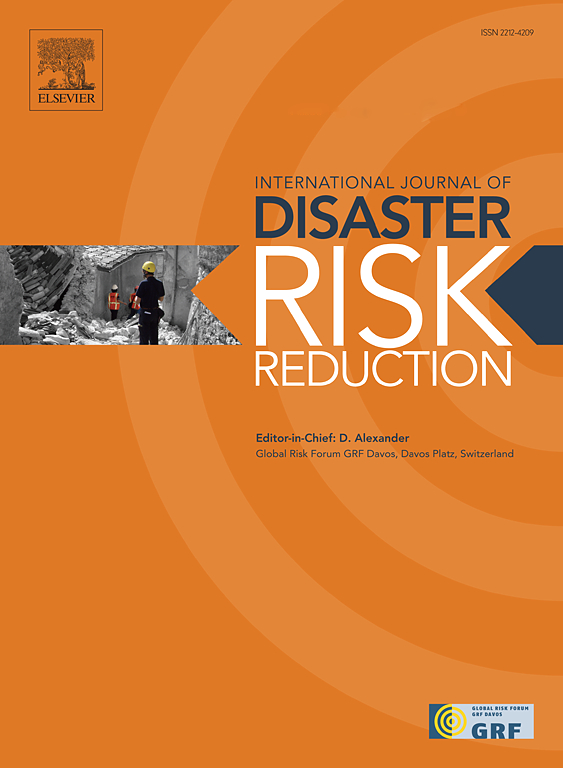Mitigation behaviors of homeowners and renters in the wildland urban interface
IF 4.5
1区 地球科学
Q1 GEOSCIENCES, MULTIDISCIPLINARY
International journal of disaster risk reduction
Pub Date : 2025-07-08
DOI:10.1016/j.ijdrr.2025.105688
引用次数: 0
Abstract
Residential development within the wildland-urban interface (WUI) has greatly expanded in the United States since the 1990s, amplifying wildfire risk by placing people and structures in greater proximity to flammable vegetation. Household wildfire mitigation actions can vary substantially by cost, knowledge required, and perceived effectiveness, but few studies have examined them separately and how their adoption varies by housing tenure in the context of wildfires. To address this gap, we surveyed residents living in WUI areas within Southern California near recent burn scars in the Santa Ana and San Bernardino Mountain ranges. Drawing on the Protection Motivation Theory and the Theory of Planned Behavior, we evaluated the factors driving the adoption of five Wildfire Mitigation Intention or Implementation (WMII) action types: fire insurance, structural retrofits, exterior minor maintenance, exterior vegetative measures, and community actions. Findings indicate that self-efficacy (perceived ability to undertake protective measures) and response efficacy (perceived effectiveness of a protective measure) are positively associated with all action types, with self-efficacy having a stronger association. Factors associated with implementation or intention to take mitigation action differed across action types. Renters reported lower levels of mitigation overall and faced greater financial and knowledge barriers. Findings stress that wildfire mitigation programs should account for how knowledge, resources, and abilities to take different WMII actions vary by housing tenure. Findings suggest that wildfire emergency officials should focus on capacity building and public education initiatives for WUI residents, with a particular focus on addressing the unique challenges renters face in high-risk areas.
荒地城市界面中房主和租房者的缓解行为
自20世纪90年代以来,美国在荒地-城市界面(WUI)内的住宅开发得到了极大的扩展,由于将人员和建筑物置于更靠近易燃植被的地方,从而加大了野火的风险。家庭野火减灾行动可能因成本、所需知识和感知效果而有很大差异,但很少有研究单独审查这些行动,以及在野火情况下,这些行动的采用如何因住房权属而异。为了解决这一差距,我们调查了居住在南加州圣安娜和圣贝纳迪诺山脉最近烧伤疤痕附近的WUI地区的居民。利用保护动机理论和计划行为理论,我们评估了推动采用五种野火缓解意图或实施(WMII)行动类型的因素:火灾保险、结构改造、外部次要维护、外部植被措施和社区行动。研究结果表明,自我效能感(感知到采取保护措施的能力)和反应效能感(感知到保护措施的有效性)与所有行动类型呈正相关,其中自我效能感的相关性更强。与实施或打算采取缓解行动相关的因素因行动类型而异。租房者报告的总体缓解程度较低,面临更大的财务和知识障碍。研究结果强调,野火缓解计划应考虑到采取不同WMII行动的知识、资源和能力如何因住房权属而异。研究结果表明,野火应急官员应重点关注WUI居民的能力建设和公共教育举措,特别关注解决高风险地区租房者面临的独特挑战。
本文章由计算机程序翻译,如有差异,请以英文原文为准。
求助全文
约1分钟内获得全文
求助全文
来源期刊

International journal of disaster risk reduction
GEOSCIENCES, MULTIDISCIPLINARYMETEOROLOGY-METEOROLOGY & ATMOSPHERIC SCIENCES
CiteScore
8.70
自引率
18.00%
发文量
688
审稿时长
79 days
期刊介绍:
The International Journal of Disaster Risk Reduction (IJDRR) is the journal for researchers, policymakers and practitioners across diverse disciplines: earth sciences and their implications; environmental sciences; engineering; urban studies; geography; and the social sciences. IJDRR publishes fundamental and applied research, critical reviews, policy papers and case studies with a particular focus on multi-disciplinary research that aims to reduce the impact of natural, technological, social and intentional disasters. IJDRR stimulates exchange of ideas and knowledge transfer on disaster research, mitigation, adaptation, prevention and risk reduction at all geographical scales: local, national and international.
Key topics:-
-multifaceted disaster and cascading disasters
-the development of disaster risk reduction strategies and techniques
-discussion and development of effective warning and educational systems for risk management at all levels
-disasters associated with climate change
-vulnerability analysis and vulnerability trends
-emerging risks
-resilience against disasters.
The journal particularly encourages papers that approach risk from a multi-disciplinary perspective.
 求助内容:
求助内容: 应助结果提醒方式:
应助结果提醒方式:


